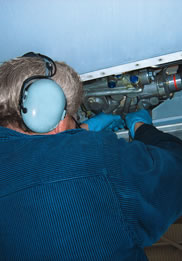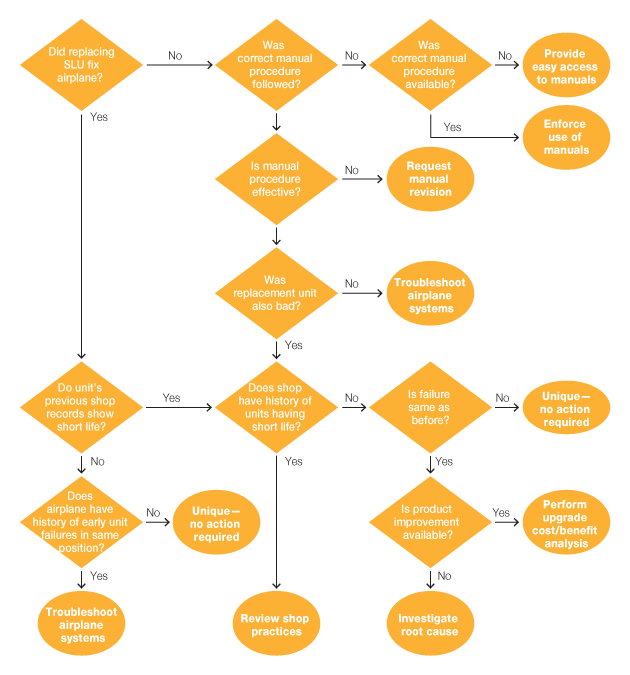

The component removal reduction (CRR) process has evolved significantly since an article about it appeared in AERO magazine more than 10 years ago. Automating the process can save considerable time and help operators reduce maintenance costs.
By Sidney Oakes, Field Service Representative, Product Support Engineering
Automating the component removal reduction process means operators get results quickly and identify root causes sooner.
The CRR process consists of identifying components removed from an airplane after a short time in service; analyzing the causes of the components’ short life in service; and eliminating those causes. Possible causes include failure to incorporate the latest component or airplane modifications, inadequate repair shop processes, failure to follow airplane maintenance manuals, ineffective maintenance manual processes, inadequately trained maintenance technicians, and non-availability of proper tooling.
The CRR process can also identify rogue units that should be scrapped because repeated repair attempts have not improved their life.
This article provides information about how operators can automate the CRR process to get faster results and reduce maintenance costs.
Updating the CRR process
In the first quarter of 2000, an article published in AERO magazine titled “Component Removal Reduction” described a process to help operators solve delay problems and reduce the unscheduled removal of components. The article explained how Boeing established a process that reduced the number of unscheduled removals of line replaceable units (LRUs) for a 737 operator with a fleet of four airplanes. By following this process, the operator was able to reduce the number of replacements for LRUs from 32 to 18 per month. Any operator, regardless of fleet size, could follow the CRR process to reduce the number of LRU replacements.
Although the original manual approach worked well for a small fleet of airplanes, larger operators immediately began exploring ways to make the process less labor intensive in order to save time and money. One large component maintenance and repair organization (MRO) created a computer program based on the CRR process to help find short life units (SLUs), rogue units, and other sources of avoidable costs. After six months, the quality assurance engineer on the project discovered that the MRO had realized more than $1 million in reduced maintenance cost using the computerized process.
Saving time by automating the CRR process
The computerized process reduces the time required to perform the CRR analysis while shortening the time from the removal of an LRU from an airplane until it is identified as an SLU. The process typically leads to identifying the cause of the short life and suggests ways to eliminate the cause(s). The process has two steps.
Extract data from maintenance records. First, operators should design a database query to extract the data that is needed for CRR research. As an example, a query using test data produced a list of almost 4,000 activities involving components removed for failure and related installations during a two-month period. Four thousand activities is an overwhelming amount of data to analyze manually, but these results can be moved into a spreadsheet to simplify analysis (see fig. 1). A spreadsheet enables the analysis to be completed in minutes.
Figure 1: Spreadsheet analysis of component removal reduction data
Each activity record includes the part number, serial number, installation, removal, airplane total hours, and other information as required for analysis.
| MR_PCN_ | DASH_NB | PART_INS | PTT_HR | ARR_FLT_OR | NOSE_NB | DFCT_TXT | ACTN_TXT | ACFT_POS | VST_STN_ID |
| 29100 | 000033 | Y | 44287 | 16-May-08 | 2999 | HYD PUMP DE | :REPLACED AIR | 1 | ORD |
| 23994 | 000047 | 44333 | 20-May-08 | 2999 | 18MAY SFO D | 820MAY SFO RF | SFO | ||
| 23994 | 000058 | Y | 44333 | 20-May-08 | 2999 | 18MAY SFO D | 820MAY SFO RF | SFO | |
| 27860 | 000060 | 44456 | 29-May-08 | 2999 | 30MAY IAD R | :INBOUND NO M | 2 | IAD | |
| 24223 | 000166 | 44248 | 14-May-08 | 2999 | APU ELECT W | :REPLACED APU | SFO | ||
| 24102 | 000169 | 44491 | 31-May-08 | 2999 | 26 MAY DEN C | 801JUN LAX RPL | 2 | LAX | |
| 24223 | 000181 | Y | 44248 | 14-May-08 | 2999 | APU ELECT W | :REPLACED APU | SFO | |
| 23409 | 000194 | 44369 | 23-May-08 | 2999 | 22MAY NRT D | 823MAY NRT RP | 1 | NRT |
Reduce and refine the gross data. After the relevant data has been extracted, operators can use a spreadsheet macro to automate the process of discovering when a particular part was installed and then later removed, calculating the total hours the part was on the airplane, and determining whether it was an SLU, based on the operator’s definition of short life. The resulting summary sheet shows how many hours each unit was in service, with shortest life units listed first (see fig. 2). Once the database query and spreadsheet macro have been created, an operator of a large fleet can arrive at this point in the CRR process in less than 15 minutes.
Figure 2: Refining data to locate short life units
This summary sheet, which can be produced quickly using a spreadsheet macro, shows the number of hours each unit was in service, with shortest life units listed first.
| ACTN_TXT | FT_POSN | /ST_STN_I | RT_REPL_ | ATA_CD | ATA_TITLE | FLEET_ID | Hrs on Wing |
| 811MAY LA | 2 | LAX | F | 314002 | LWR EICA | 757 | 1 |
| :REPLACE | 4 | PUS | F | 361200 | PNEUMAT | 747 | 1 |
| :REPLACE | CTR | DEN | F | 233710 | PASGR EN | 777 | 2 |
| :REPLACE | 1 | SFO | F | 235101 | PANEL, A | 757 | 3 |
| :ACP MM | 1L | IAD | F | 276400 | SPOILER | 757 | 3 |
| :REPLACE | 2 | IAD | F | 235101 | PANEL, A | 757 | 4 |
| :NO VEP A | 3 | NRT | F | 233710 | PSGR EN | 777 | 6 |
| :REPLACE | 3 | DEN | F | 344803 | CENTER II | 757 | 6 |
In this example, the low in-service times (i.e., hours on wing) listed are unacceptable, and corrective action is required to reduce maintenance costs and improve on-time performance. An investigation can be performed for each unit and action taken to eliminate the cause of early removal. The primary focus can be on the life of SLUs or on the most expensive units. For example, the failure of an integrated drive generator would be a higher priority than the failure of an audio panel. The solution for a single unit is often the solution for an entire group with that part number.
Determine corrective action
Boeing has created a flow chart that operators can use to determine what corrective action needs to be taken to eliminate the cause of an SLU’s short life (see fig. 3).
Figure 3: Short life unit (SLU) decision tree
Operators can use this decision tree to determine how to eliminate the cause of an SLU’s short life.

In addition to the decision tree, Boeing offers three other ways to facilitate the process of determining root cause:
- Identifying maintenance errors. Since 1995, Boeing has offered operators a human factors tool called the Maintenance Error Decision Aid (MEDA) for investigating contributing factors to maintenance errors (see AERO second-quarter 2007). This process can help identify maintenance errors that may have caused the early removal of a component.
- Product and process improvements. Fleet Team Xchange, which Boeing introduced in December 2009, is an online collaboration tool for in-service issues (see AERO second-quarter 2010). Fleet Team Xchange, available through the Web portal MyBoeingFleet.com, often includes discussions about component reliability issues. Operators can ask questions regarding issues found in the process described in this article. Many times, other operators have already found the solution for a given issue.
- Automatic monitoring. Boeing’s Airplane Health Management Performance Monitoring provides automated monitoring of fuel consumption and CO2 emissions (see AERO third-quarter 2009). The module enhances viewing, managing, and researching of, and acting on, airplane performance data to optimize airplane operation and support maintenance decision-making. The module also provides a linkage between the performance and maintenance domains, allowing for a common toolset that addresses systems’ condition and fuel performance.
Summary
The CRR process consists of listing components installed in an airplane and removed after a short time in service, analyzing the cause of the short life in service, and correcting that cause. By automating this process, operators can get results quickly and identify root causes sooner, ultimately reducing maintenance cost.
For more information, please contact BFSSSC@boeing.com.

